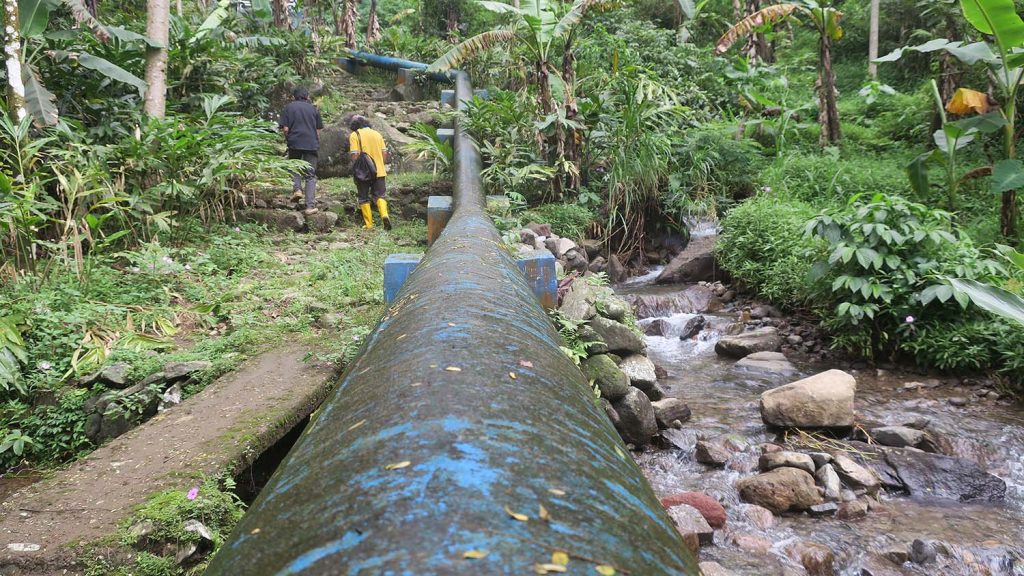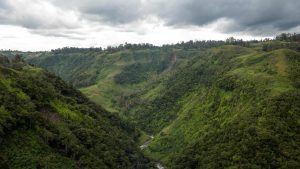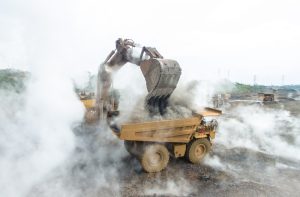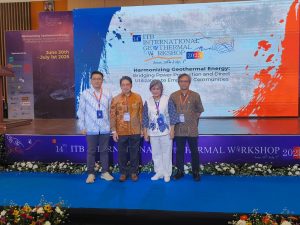
by: Hartatik
Semarang – Water resources in Central Java Province hold energy potential of up to 382.32 Mega Watts (MW). One of them is located in Banyumas Regency. With its geographical condition on the slopes of Mount Slamet, Banyumas has 1,681 springs and five ponds.
The potential of the streams and ponds is quite good, as they are located in a protected forest area, so the water availability is abundant. Many streams flow over steep cliffs.
Regarding hydro climatology and the water cycle, the Mount Slamet region is a rainwater catchment and absorption area, as well as a source of water for several watersheds that flow around it.
The Banyumas Energy and Mineral Resources Agency (ESDM) has mapped at least seven watersheds with potential as sources of electricity, namely the Upper Cihaur Watershed, Tajum Watershed, Logawa Watershed, Pelus Watershed, Lower Serayu Watershed, Ijo Watershed, and Tipar watershed. This is in addition to the potential of waterfalls in seven other waterfalls spread across Baturraden, Kedungbanteng and Cilongok sub-districts. These areas are located on the slopes of Mount Slamet and have many streams. The existence of these high-discharge springs and ponds is used by some people for electrical energy purposes, especially those who live in remote areas far from the PLN electricity network, such as on the slopes of Mount Slamet.
“We are intensifying the use of renewable energy in rural communities. This is one of the steps to reduce carbon emissions in Central Java,” said the Head of the Energy and Mineral Resources Agency of Central Java Province, Sujarwanto Dwiatmoko.
Of the total 8,000 villages in Central Java, he continued, there are currently around 2,300 villages that are energy independent. The development of new renewable energy is carried out by providing assistance in many districts/cities, including micro-hydro power plants (MHP). The local community can also enjoy environmentally friendly energy cheaply, even free for 24 hours.
Buying MHP electricity
Manager of Revenue Insurance and Commercial Mechanism, PLN UID Central Java and DIY, Muhammad Hamzah, in the webinar “Central Java Solar Day”, revealed that the Central Java Provincial Government is considered capable of realising the target of using new renewable energy (NRE) of 21.32 per cent by 2025. However, it does not come from developing rooftop solar power plants (PLTS), but from micro-hydro power plants (MHP).
“Central Java’s target of 21.32 per cent can be achieved because it is widely supported by PLTMH,” Hamzah said.
He revealed, since 2016, electricity purchases from MHP have continued to increase. Data from 2016, the purchase of electricity from the MHP was 34 thousand Mega Watt hour (MWh). This figure jumped significantly in 2020 to 122.69 thousand MWh. Hamzah said, currently there are 50 MHP entities that want to sell electricity to PLN. However, in the near future PLN can only buy 4 entities with 8 Mega Watt (MW) of power.
“In the near future, 3-4 entities will enter with a power of around 8 MW, so there will be around 32 megawatts in 2021,” said Hamzah.

Meanwhile, Adhityo Nugraha Barsei, a researcher from the National Research and Innovation Agency (BRIN) revealed that currently there are still 19,565 villages in Indonesia that do not have access to electricity. Their needs should be met with better means, namely by prioritising clean and sustainable energy sources.
Village-based clean energy development models can be multiplied in various regions, to increase national clean energy capacity and community access to energy. “In planning the development of clean energy based on citizens or communities, the village government can be the base. The village government can involve the role of residents as managers under a certain legal entity,” he explained.
Community-based
The same thing was expressed by BRIN Governing Board Member Tri Mumpuni, who has been actively developing villages for 30 years with her husband Iskandar Budisaroso through MHP. The director of the Institute of Business and Economic Democracy (IBEKA) said that the installation of MHP is not difficult. The principle is to utilise water discharge to drive a turbine that will produce mechanical energy. Furthermore, this mechanical energy drives the generator and produces electricity.
There are only a few physical requirements needed to build an MHP, namely that it must be built in an area that has a constant availability of water flow in a certain size of discharge. The size of the water discharge will determine the amount of energy that can be generated. Then, the MHP circuit requires a turbine to rotate the electric dynamo coil. The dynamo is to convert the energy generated by the turbine’s rotation into electricity and the power grid is to distribute electricity from the MHP installation to the user.
Compared to other energy sources, micro-hydro power plants are economically very efficient and easy to maintain. However, the sustainability of MHP depends on community participation and mastery of the technology.
“If the community understands, they no longer need PLN,” said Mumpuni.
This principle has enabled her to build 82 MHPs in Indonesia since 1997 in remote villages, without involving the government. Furthermore, the 2012 Ashden Award winner said that she did not work alone in building power plants that utilise river flow. She involved the village head and the local community by creating an organisation or community that will learn together to build the turbines and maintain them.
Mumpuni added that every village has unique natural resource potential for electrical energy generation. One of the great potentials that Indonesia has is water. However, the magnitude of electricity potential from water has not been managed optimally.
Based on a report by the Directorate General of Electricity of the Ministry of Energy and Mineral Resources in January 2020. water energy in Indonesia that has been utilised until 2019 is 5,976.03 MW or around 6.4% of the total potential. Whereas the potential of water energy in Indonesia is estimated to reach 94,449 MW. The potential that can be utilised as a hydropower plant (PLTA) is 75,091 MW, and for minihydro and microhydro power plants is 19,358 MW.
“MHP is an alternative solution that can overcome the limitations of access to transport, technology, and cost. In some areas, there are already MHPs that are on grid with PLN. In fact, our institution is the first in Indonesia to grid MHP, and then adopted by the UN in ASEAN and African countries to bring income to the community,” explained Mumpuni.
Furthermore, according to her, MHP does not use fuel oil at all, so there is no exhaust gas generated from the use of this technology. The application of micro-hydro power plants is a positive effort as one of the efforts to emit greenhouse gases in the energy sector with a focus on renewable energy.
GHG emissions are one of the triggers for an increase in the earth’s temperature, which causes global warming and results in climate change. Thus, the development of MHP has a positive impact on the environment and is in line with low-carbon development policies.
*This article first appeared on tanahair.net 13 December 2022













